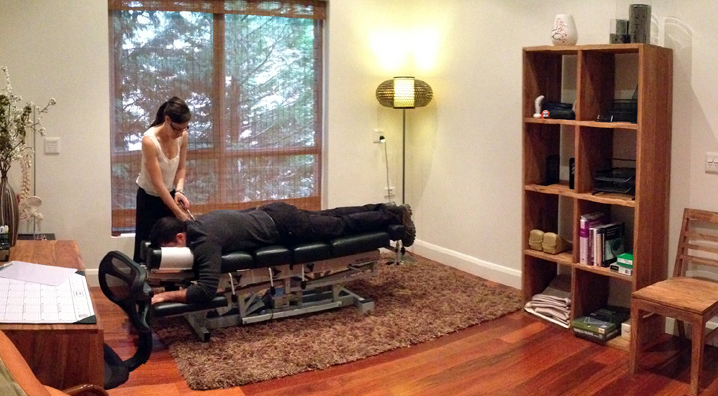Thanks to Dr Mel Kheradi from Neurohealth Chiropractic in Riverview/Lane Cove, for explaining to us exactly what a Chiropractor actually does. Over to you, Mel!
What does a chiropractor do?
You often hear of friends and family who have visited the chiropractor describe the experience as “having their backs cracked”.
The job of a chiropractor is far more than just back cracking. For those chiropractors who have completed their studies in Sydney, they attend university for 5 years. They complete both a Bachelor and Masters degree in Chiropractic science, where the undergraduate program is the equivalent of a medical science degree, plus a few extra chiropractic specific subjects. Meanwhile throughout the Masters degree, chiropractic student complete two years of clinic internship and hone in on their diagnostic skills, anatomy and physiology skills, pathology and neurology skills as well as radiology. These student have a 40 hour contact week at university and at some stages along their studies have up to 20 exams in one exam period.
Going from being examined at university for the their skills in diagnosis, therapy, neurology and anatomy, the chiropractic professional moves into the examiners role.
Chiropractors examine their patients to work out where the source of the pain and dysfunction in their spine is and how it is impacting other joints, muscles and function. It is a big picture approach and may require further evaluation that might include an x-ray or a referral to another health professional. An orthopaedic and neurological exam will be conducted to work out what is going on and to construct and treatment plan. Whilst some patients benefit from manual therapy, others benefit from low force techniques. Either way your chiropractor will determine what will be the most effective treatment method for your body type. You may also be given exercises and stretches that aid in restoring balance and addressing anything in the spine that has gone haywire.
There are many movements that are hard wired into the nervous system, movements that the body performs without giving it too much thought. For example we breathe somewhere in the vicinity of 20000 times per day. This means that the diaphragm muscle and all the other associated breathing muscles contract 20000 times per day. Same goes for walking, there is a rhythmic system of muscles turning on and off in an accurate sequence to pick up our legs in a co-ordinated fashion to result in our gait. These are referred to as automated movement patterns.
Whether we are breathing, running, swinging a tennis racket or sitting at the computer, virtually every movement we make and every position that the body adopts involves some form of spinal stability. The spine and trunk are the pillars of the human frame, our movements and postures.
The movement and postures that we adopt are not the sole responsibility of our muscular system. Muscles play a role in signaling feedback to the brain about where your body is positioned and how well the required movement (e.g swinging a tennis racquet) was actually performed. Your brain then decides whether there is a need to make any adjustments to fine-tune the movement we wanted to achieve. This feed forward and feedback system is more properly termed the sensory motor system. Motor -meaning the intended movement and sensory – referring to the feedback to the brain.
This sensory motor system (or lack of) is easy to see in toddlers in their walking and feeding for example. When a baby first starts to walk they tend to fall and waver, tilt and stumble. When a baby first learns to feed themselves a great deal of their food ends up on their face, bib or on the floor. Adorable and tangible examples of a lack of development in the sensory motor system that co-ordinates our movement, highlighting how this system lacks when it is still evolving.
By the time toddlers have evolved into adults most of them walk and eat without a second thought. In fact we do many other things such as swing a tennis racket and running with relative ease too. We can do this because we learn motor skills through practice. The brain signals a muscle the intended action and once this has been completed, the muscle sends a message back to the brain about how good of a job has been done and whether any further fine tuning is needed. For those of us that have poor co-ordination and are not necessarily gifted with athleticism, probably don’t have that fine-tuning down pat.
The fine-tuning necessary in the spinal muscles is nothing short of elaborate. The spine is involved in every movement and every posture, so whether you are a developing baby learning to walk or a pro tennis player, either way the spine is involved and online constantly. Since our spine is involved in all postures as well, then the brain is reliant on feedback from the spine when we are positioned in postures such as standing, sitting, studying or working at a desk.
It would be reasonable to assume that an when an elaborate system of spinal muscles becomes disrupted in any way, regardless of the degree of disruption, then this will ultimately have an impact on how every movement is executed and how every posture is adopted.
As far as a chiropractor is concerned, they need to assess and decipher this elaborate system, to determine of the source disruption and how the disruption is impacting other joints, muscles and function. Once you have undergone a thorough initial exam and possibly been referred for X- rays, should further evaluation be warranted, the next step is to design a treatment plan that is tailored to your needs.
Tailored therapy is required because the same ailment may have a different cause in different people. Diagnosis and an appropriate course of action is one of the many reasons that chiropractors have university level qualifications. Once they have worked out what has gone wrong and how they can fix it, then your chiropractor will also reassess and monitor your progress on an ongoing basis.
So chiropractic is the art of assessing, diagnosing, monitoring and the treating of ailments of the musculoskeletal system and the sensory motor system. So the next time either you or someone you know goes to the chiropractor and gets their back cracked, what your chiropractor is actually doing is:
- Identifying the source of dysfunction
- Determining which treatment is most suitable for that particular issue on that particular person on that particular day.
- Treating the cause of the problem
- Giving you further therapeutic advise that may be helpful.
Whether you have had an injury or have poor posture, or you have a child who has limitations in their sensory motor system, chiropractic is a natural and holistic approach to improving body and health.
Neurohealth Chiropractic
Address: 45a Tambourine Bay Road, Lane Cove NSW 2066
Phone: 9418 7673
Mobile: 0421 551 257
Website: http://neurochiropractic.com.au
Do you have a local issue you would like help with? ITC is here to help just email us at [email protected]
You can subscribe to our newsletter by filling out the form at the bottom of our homepage. Our newsletter is sent out every Wednesday Night at 7.30pm and includes details of Lane Cove Events for the next seven days or so, and articles you may have missed during the previous week.
Have you liked our Facebook page or Instagram Page – what are you waiting for?!















